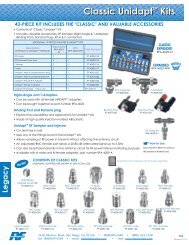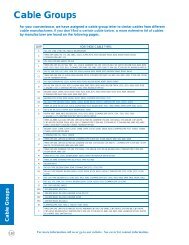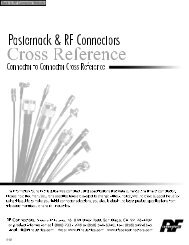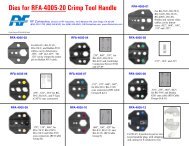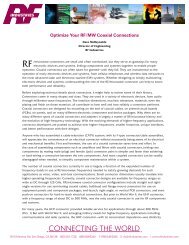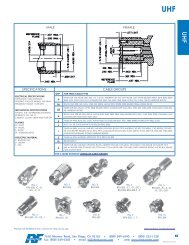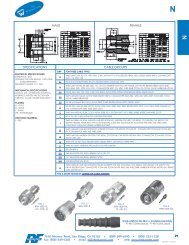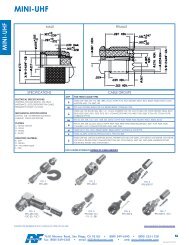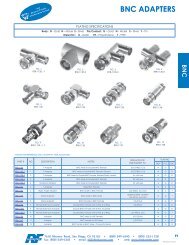RF Connectors Complete Catalog Download
RF Connectors Complete Catalog Download
RF Connectors Complete Catalog Download
Create successful ePaper yourself
Turn your PDF publications into a flip-book with our unique Google optimized e-Paper software.
Crimp-on<br />
This fabrication method has always been the workhorse of the industry, and is probably the most frequently used<br />
method of terminating connectors on coax cable.<br />
The crimp method is the most popular because:<br />
• There is no need for soldering; therefore, installation time is reduced.<br />
PREFERRED<br />
1. Equal compression on all 6 crimp surfaces<br />
2. Crimp die positioned within pin step down<br />
• It takes an experienced technician about 15 seconds to install a crimp-crimp connector, thereby greatly<br />
reducing the time required to create cable assemblies. This is very important in today’s cabling market where<br />
time is of the essence and fewer technicians are being asked to maintain more and more equipment. Digital<br />
video, computer and network cabling is almost universally crimped today.<br />
• Crimped connections, done correctly, can be superior to soldered connections.<br />
• A good crimped connection deforms the metal sufficiently past the yield point, but not too much, so that the<br />
"spring back" keeps the connection secure, even under thermal cycling (the coefficient of expansion of the<br />
two metals might be different) and vibration.<br />
• A good crimp connection is gas tight and won’t wick: it is sometimes referred to as a “cold weld”.<br />
• Like the solder method, it can be used on solid or stranded conductors, and provides a good mechanical and<br />
electrical connection.<br />
Disadvantages of the crimp method are:<br />
• If done poorly, the crimped contact will not seat properly within the connector taking the interface out of<br />
specification. Both signal continuity and quality will suffer.<br />
NONCONFORMING<br />
1. Position of crimp die is outside crimp area<br />
2. Body of pin is no longer concentric<br />
3. Impedance of connector will be affected<br />
NONCONFORMING<br />
1. Pin has been distorted, is no longer straight<br />
2. Pin has begun to break at crimp Pin shows “dog ear” of excess material<br />
3. Possible cause: wrong crimp die or too much pressure applied<br />
• Crimped contacts cannot be un-crimped and re-installed. In many cases, this means the entire connector assembly must be<br />
scrapped and replaced by a new one.<br />
• Crimped connections on solid wire can be poor and prone to failure, unless crimped with the proper dies using professional<br />
crimp handles.<br />
• Sometimes, although rarely and under conditions of frequent flex, stranded wire can shift within the crimped joint and loosen.<br />
This occurs more frequently with clamp connectors than connectors with crimped ferrule studs.<br />
• Some important points to remember when using the crimp method are to select the proper connector for the coax you are<br />
using. A tight fit on the inner conductor before crimp and the proper ratio of ferrule stud ID to cable dielectric OD and ferrule stud<br />
OD to ferrule ID is important to avoid a substandard crimp. Avoid double crimping, especially on the contact; this is known as<br />
"flagging" or “dog ears”.<br />
REFERENCE<br />
7610 Miramar Road, San Diego, CA 92126 • (858) 549-6340 • (800) 233-1728<br />
fax: (858) 549-6345 • email: rfi@rfindustries.com • web: www.rfindustries.com<br />
Revised 7-27-2013<br />
179



